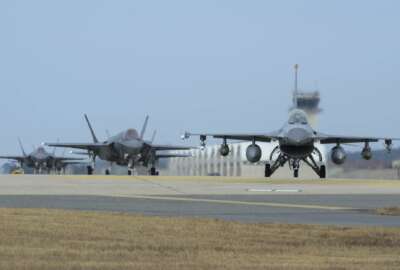Best listening experience is on Chrome, Firefox or Safari. Subscribe to Federal Drive’s daily audio interviews on Apple Podcasts or PodcastOne.
The Defense Department says it will have a plan to make climate change a main factor in the further strategy of the military’s operations, risk assessments and programming by Sept. 1.
The plan is required by a Jan. 27 executive order put into place by the Biden administration, and has the potential to effect nearly every aspect of how the military plans.
During a House Armed Services Readiness Subcommittee hearing, Paul Cramer, who is performing the duties of assistant secretary of defense for sustainment, said DoD is using the executive order to respond to climate change by enhancing military resiliency and reducing environmental harm.
“The primary purpose is to integrate climate change adaptation and climate resilience across our programs, management of real property, our public lands and waters and financial services,” Cramer said.
A 2018 DoD study found that more than a thousand military bases were vulnerable to effects of climate change.
While DoD is not ready to release the plan, Cramer said it will be based around five lines of effort:
- Climate-informed decision making, where climate considerations must continue progress towards becoming an integral element of DoD’s enterprise resource allocations and operational decision-making process.
- Train, test, and equip a climate-ready workforce, which will help shape the Department’s efforts across activities related to developing, acquiring, fielding and sustaining equipment and services.
- Resilient built and natural infrastructure.
- Supply chain resilience and innovation, where DoD can be assured that key suppliers and industries can still operate while impacted by climate change with uninterrupted access to key supplies, materials, chemicals, and services.
- Enhanced adaptation and resilience through collaboration where DoD will build unity of effort in mission across DoD components to exploit lessons learned and economies of scale and integrate that into existing DoD missions.
The executive order requires DoD to develop and submit “an analysis of the security implications of climate change (Climate Risk Analysis) that can be incorporated into modeling, simulation, war-gaming, and other analyses.”
It also states that DoD must consider the security implications of climate change when developing the National Defense Strategy, Defense Planning Guidance, Chairman’s Risk Assessment and other relevant strategy, planning, and programming documents and processes.
Starting in January 2022, DoD must provide an annual update, through the National Security Council, on the progress made in incorporating the security implications of climate change into documents and processes.
The individual military services are also developing their own plans and objectives within the parameters of the executive order.
Jennifer Miller, acting assistant Air Force secretary for installations, environment and energy, said the service is looking at reducing operational energy consumption and costs since it makes up 80% of the branch’s energy use.
“One of the things that we’ve been able to get funded this year is some of the relatively small items, whether it’s the angling of our windshield wipers on our aircraft, the little winglets, to things that we’ve been able to modify the aircraft,” she said. “We are often stealing good ideas from industry. All of these things we’ve been able to implement for less than $40 million this year have a return on investment within the future year’s defense plan and have some real opportunities for big savings, although they are little investments.”
Miller said the Air Force is also looking at new telework policies to reduce its environmental footprint. Miller said the service is working on determining installation energy and water vulnerabilities as well.
Miller’s Navy counterpart, Todd Schafer, said one main issue is that rising sea levels are putting costal bases at risk.
“We’re working to build a resilience plan, we work with local, county and state governments to ensure that we’re good partners with the community,” he said. “We’re also looking at the effects of climate change on things such as energy, water and also the cyber piece of this and what it can do for our control systems.”
The Navy is also running “black” exercises where it takes bases off the local power grid and forces them to work with an independent power source.
“Climate is a big deal for us. We’re prioritizing it into all the actions we do and we’re doing that to build climate resiliency into all of our infrastructure,” Schafer said. “That includes our master planning, our development, our design and construction, and then also it’s in all of our decision making processes.”
Jack Surash, acting assistant Army secretary for installations, environment and energy, said the service put together a climate working group in late February.
“We really see climate change having a big effect on the operating forces of the Army – the training, deployment, employment of operating forces and the need for such, as well as very obvious implications on our installation side,” he said.
Surash said in the next two months the Army will have a climate change strategy with a detailed action plan laying out a multi-year effort that covers operating forces and installations.
Copyright
© 2024 Federal News Network. All rights reserved. This website is not intended for users located within the European Economic Area.





